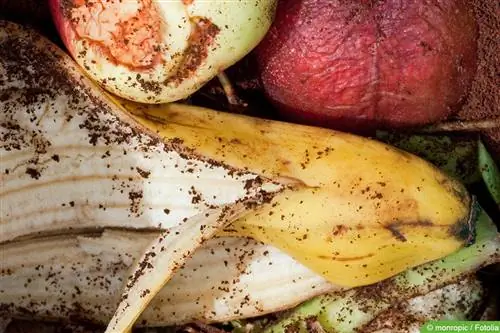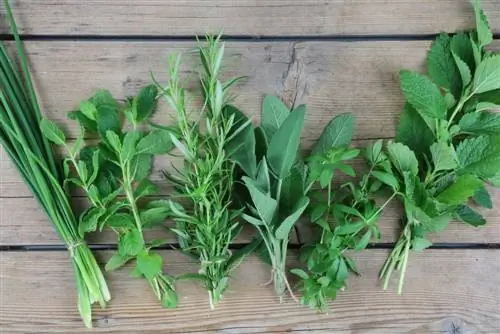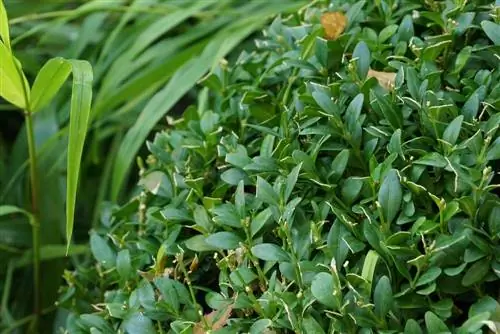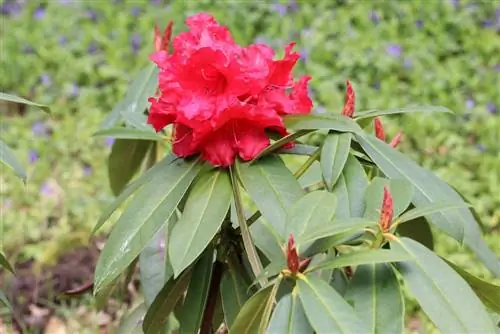- Author admin [email protected].
- Public 2023-12-17 03:39.
- Last modified 2025-01-24 12:45.
The vacation was nice, but a bad surprise awaits you at home because some plants in the garden bed or in the pots on the terrace and balcony have dried up. Houseplants can also suffer if you forget to water them. However, the question now arises as to how damaged the plant has already been and whether it can still be saved. The wrong location can also be to blame for one or another plant withering away. The following article deals with what help is available and how the dried plants can be saved.
Inspection
Anyone who discovers dried plants should first check carefully whether it would still be worth saving them or whether the affected plant is irrevocably lost. Above all, the normal lifespan of a plant should also be taken into account. If it is an annual plant that dies in the fall anyway and then dries up in the last months of summer, then it would be a waste of effort to try to save this plant again. However, the situation is different with perennial plants, where saving should be the priority. It is therefore important to examine the dried plant carefully and pay attention to signs that could indicate life:
- Leaves turn yellow, but have not yet dried out dark
- Flowers hanging
- Leaves are shed when green
However, if the plant has already withered and dried out completely, then any help is usually too late. To test, small branches and twigs are broken off. If these are already dry on the inside and no longer appear green, then the affected plant may no longer be able to be saved. If no new shoots appear after the first aid measures, then this specimen should only be disposed of. However, if only a few branches have been affected by the drought so far and the main trunk is still slightly moist and green, then a rescue operation can be successful.
Tip:
But even plants where all the branches have already dried up can still be saved if the roots are not yet damaged. Also apply first aid to these plants and wait to see whether new shoots appear directly above the roots. If this is the case, first aid was successful.
Quick first aid
If a dry or withered plant is discovered, but still shows a little bit of life, then action must be taken immediately. However, it usually doesn't do much good to water with a lot of water, as in such a case the soil around it is usually dried out and the water doesn't reach the roots at all. It is better to proceed as follows for quick first aid:
- Fill tub or bucket with water
- Place the plant with the bucket in the water
- the bucket must have a drainage hole
- Carefully dig up small bedding plants and place them in water
- leave it in the water until no more air bubbles form
- then let it drain
- avoid waterlogging of potted plants
- Place the bucket up so that the water can drip out of the hole
- remove dried shoots and leaves
- possibly cut back to the root ball
If the bucket is too big for a water bath, you can alternatively place it on a saucer filled with water. However, caution is advised here; the bucket must not remain in the water for longer than 24 hours, otherwise there is a risk of waterlogging. If no more water is absorbed from the plate via the drainage hole after 24 hours, the plant has had enough.
Tip:
The dried and withered branches and shoots must be removed from the ground because although they have already died, the plant still uses too much energy because of these dead parts. So that it can create the strength to form new shoots, removing it is essential and sensible.
Check location
Especially with potted plants on the balcony or terrace as well as with houseplants, it makes sense to check the location if the plant has dried out. If the plant is saved and returned to its unfavorable location, it can happen that the newly formed shoots dry out again. Therefore, it makes sense to look for a new location for the saved plant. For example, the houseplant may have suffered from a nearby heater in winter as well as from too much sunlight through a closed window. The balcony or terrace plants should also be moved from a very sunny spot to partial shade after being rescued; direct midday sun should definitely be avoided. The young, newly formed shoots in particular are even more sensitive to strong sunlight.
First aid for bedding plants
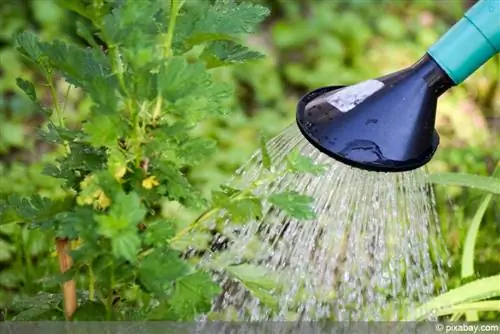
Large plants in the garden bed cannot be dug up so easily if they show signs of drying out. The first aid measures must be taken differently here. The plant needs to be provided with a sufficient amount of water every day early in the morning. When saving large plants in the garden bed, you should proceed as follows:
- 10 to 20 liters over several days
- Use a watering can, a liter is given here
- a large jug usually has a capacity of 10 to 12 liters
- water directly to the roots
- It is also helpful to loosen the soil around the plant
- piling up soil allows water to reach the roots more easily
- cut back dried shoots
- so no more power from the plant is put into it
- do not give fertilizer until the plant has recovered
- if new shoots appear, it is saved
- possibly protect the location from too much further sunlight
Tip:
Just rainwater is not enough when the soil is already dry. Even during heavy downpours, the water flows quickly to the side when the soil is dry and does not reach the roots. Therefore, it must be watered daily for several weeks.
Further initial measures
If a plant is already very dry, then there really isn't much that can be done wrong. Therefore, there are many other tips that can help but unfortunately do not have to help. Because it depends primarily on the extent to which the roots of the affected plant are already damaged whether it can be saved or not. Therefore, the following rescue measures can also be initiated:
- It is often recommended to repot a dry plant immediately
- To do this, remove the plant from the pot
- place with the root ball in a bucket of water
- wait until no more air bubbles rise
- replant in new soil
- place in a bright but not hot location
- An attempt is often made to save the plant by giving fertilizer
- but it is not clear whether this makes sense
Tip:
Some guides recommend fertilizing immediately after sufficient watering, others advise against this. If a plant is already very withered and needs to be cut back, applying fertilizer immediately can help it quickly form new shoots. Plants that have so far only been hanging and have not dried out should only be watered sufficiently so that they recover again.
After the rescue
If a plant has been successfully saved, new shoots will appear. If this is the case, care must now be taken to ensure that it does not dry out again. Especially if the soil has already dried out, it may be because the moisture is no longer stored as well. Therefore, after the successful rescue, you should proceed as follows:
- Loose up the soil and make it permeable
- add compost, sand or clay to this
- renew the potting soil for potted plants
- Mulch the soil so that the moisture cannot evaporate
- possibly change location
- If potted plants are in direct sun, protect the pot from the sun
- Also protect garden beds from the sun
- for example through plants that provide shade
- water regularly in the future
First signs
Even if a plant has not yet shown any drought damage, it can still suffer from drought. If aphids settle on a plant, it is usually weakened, which can indicate dryness and an unfavorable location, for example due to too much sunlight. Further signs of incipient dryness are those mentioned below:
- yellow leaves on bushes and trees
- produces yellow leaves on green plants
- hanging shoots and flowers
- Increased leaf shedding helps the plant save water
- this reduces the evaporation area
- already dried leaves, shoots and branches
- the drying out of the plant is already very advanced
Preventive measures
Of course, it always makes more sense to act preventively than to have to limit the damage afterwards. Especially when a beautiful, tall plant suffers drought damage, it has to be cut back very far in order to save it. It can take a few years for the specimen to become as beautiful and large as it once was. And it can also happen that a plant can no longer be saved and has to be disposed of. Therefore, it is better to prevent it as follows:
- The first priority is regular and sufficient watering
- However, always avoid waterlogging
- If necessary, change location in summer
- Better to provide light shade than full sun all day
- create an automatic water system for your vacation
- For potted plants, make sure that the pot is in the shade
- possibly protect with a parasol or tarpaulin
- also water in winter, during long periods of drought
- but only on frost-free days
Tip:
If you live in a nice neighborhood, you can also ask them to keep an eye on the garden and water it if necessary during a longer absence.
Saving withered lawns

Even a beautiful, green lawn can quickly turn yellow in summer when there is strong sunlight and high heat. But lawns in particular can easily be saved. As a preventive measure, every lawn should of course be watered in the evenings in very hot summers. But this is not always enough. If the lawn turns yellow, you should proceed as follows:
- Roots of lawns are usually not damaged
- Put the hose on the lawn and let the water run
- the water should penetrate to a depth of about 15 cm
- after a few days it will turn green again
- The yellow lawn problem usually goes away on its own
- If there is enough precipitation in autumn and winter, the lawn recovers
Tip:
To strengthen the roots, water in spring so that the roots have to grow far down to absorb the water. With such a deep root system, a relatively heat-resistant lawn is created. If you water for too short a time, the roots remain weak and the lawn dries out more quickly.
Conclusion
Even if the plants already look very withered, all is not always lost and they can still be saved. Because even if everything above the ground seems to be dry, the roots of the plants can often still contain a little life. If they then receive enough water to absorb again, the new shoots will appear directly from the roots. Therefore, everything that has dried up and withered on a plant must be cut back, even if only the pure roots are left. The dried branches and shoots can no longer be saved and must be removed so that the energy can be used to form new shoots. Therefore, even an apparently dead plant should not be abandoned immediately.


